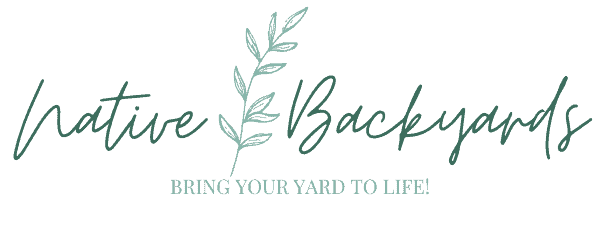Top 10 Native Perennial Flowers That Bloom All Summer
Do you want your garden to be bursting with color with perennial flowers that bloom all summer? Then these 10 native perennials are for you!
Start by downloading my FREE Long Blooming Perennials PDF. You can take this handy one-pager with you to the nursery.
Each of these long-blooming native plants not only LOOK good, they DO good by serving as butterfly host plants and important nectar sources for pollinators.
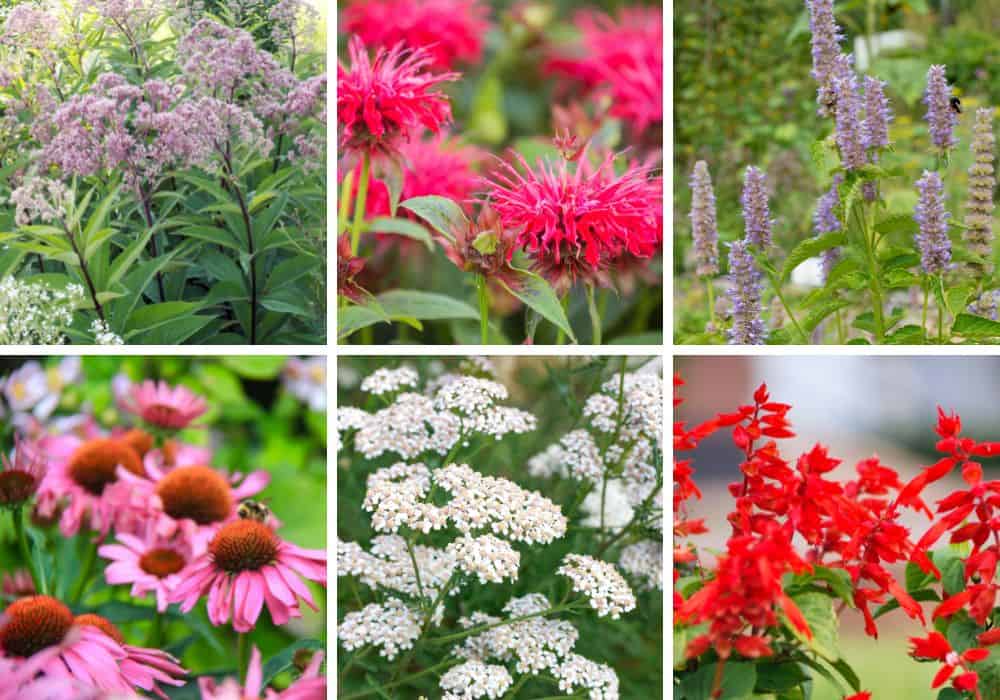
Native perennials are low maintenance, hardy plants that thrive in their local climates. Once established, they require very little regular watering beyond the average rainfall. Plant a mix of these for a wide range of colors and consistent pops of color throughout the season.
Why it is important to grow native plants
If you add any new plant to your yard, make it a native! Native plants are the foundation of a healthy ecosystem. These plants have evolved in your local area, while non-native plants were introduced from other parts of the world. Native plants:
- Are important food source to plant-eating insects
- Serve as host plants to butterflies and moths
- Require less water and maintenance
- Support more species than non-native plants
If you are new to native plants be sure to read the Top 6 Benefits of Native Plants in Your Yard. The majority of our yards are currently filled with non-native plants so there are lots of opportunities to swap in some natives and help the environment.
10 U.S. native perennial flowers that bloom all summer
Most of these perennial plants are native to large parts of the United States, and in some cases, North America. Each flower profile contains a link to a map that shows its native range. Check it out to make sure you choose plants that are native to your local area.
Many are long-blooming perennials that start in late spring and keep going strong until late summer. They perform best in full sun, but there are some that bloom well in partial shade too. Plant a wide variety of colors for a big impact!
1. Purple Coneflower (Echinacea purpurea)
These iconic purple flowers are a must for any perennial garden and look especially great paired with Black-Eyed Susan flowers. Purple Coneflowers are deer resistant but loved by pollinators. The big blooms also make great cut flowers!
Native to: Eastern half of United States
Bloom period: June-Sept (for 1-2 months during this time period)
Sun requirements: Full to part sun
Height: 1-3 ft.
Wildlife benefits: Nectar and pollen for pollinators, seeds for birds.
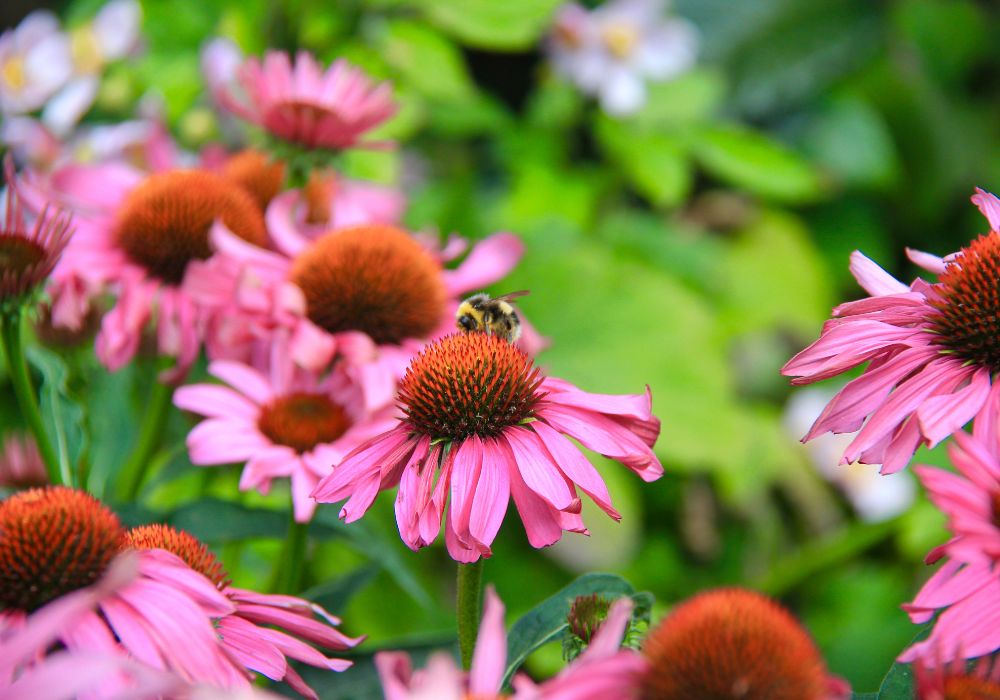
2. Turk’s Cap (Malvaviscus arboreus)
Turk’s Cap is native to the warm climates of the Southeast. It starts blooming in early summer and doesn’t let up until late fall or until the first frost.
This is the best plant for a shady area in your yard! It is one of the few plants that blooms consistently in the shade. It can handle morning sun but likes afternoon shade.
Turk’s Cap pretty red flower heads will attract lots of hummingbirds to your garden.
Native to: Southeastern United States
Bloom period: May-Nov.
Sun requirements: Part shade to full shade
Height: 3-6 ft.
Wildlife benefits: Host plant for Turk’s Cap White Skipper. Nectar for hummingbirds. Fruit for birds and small mammals. Humans can eat the fruit too!
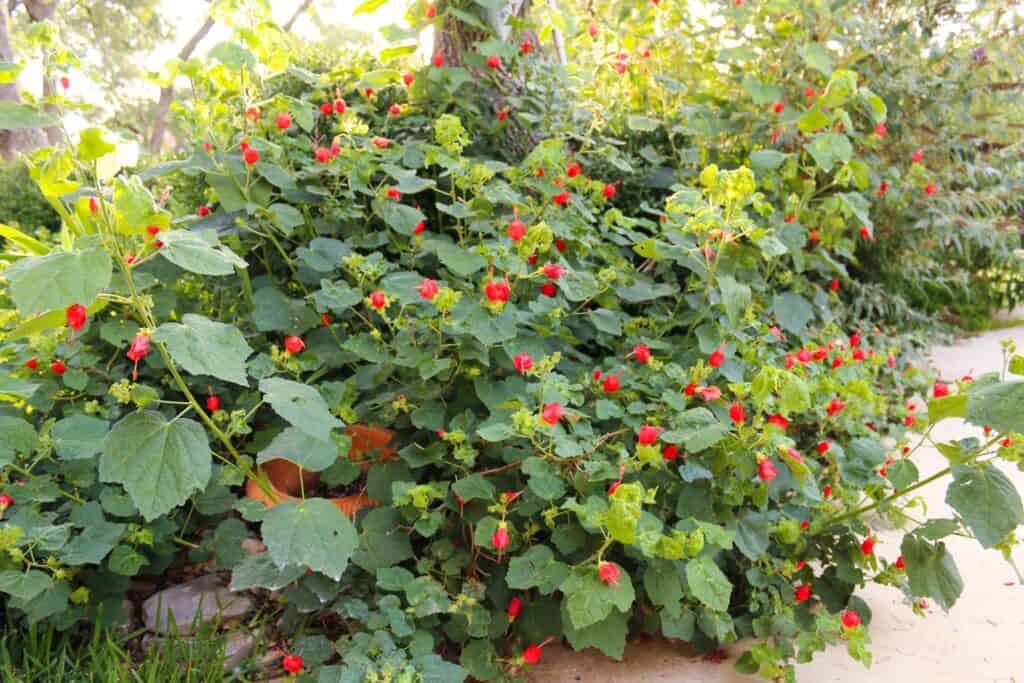
3. Frogfruit (Phyla nodiflora)
This pretty ground cover will be covered in flower spikes containing tiny white flowers with purple centers all summer long.
Frogfruit has a long bloom time that extends from May to November. It is drought resistant and can handle extreme summer heat! It is a great addition to flower beds, window boxes or container pots.
Native to: Southern half of United States
Bloom period: May – Nov.
Sun requirements: Full to part sun
Height: <1 ft.
Wildlife benefits: Host plant to three butterflies (Buckeye, Phaon Crescentspot, and White Peacock). Nectar plant for a variety of small pollinators.
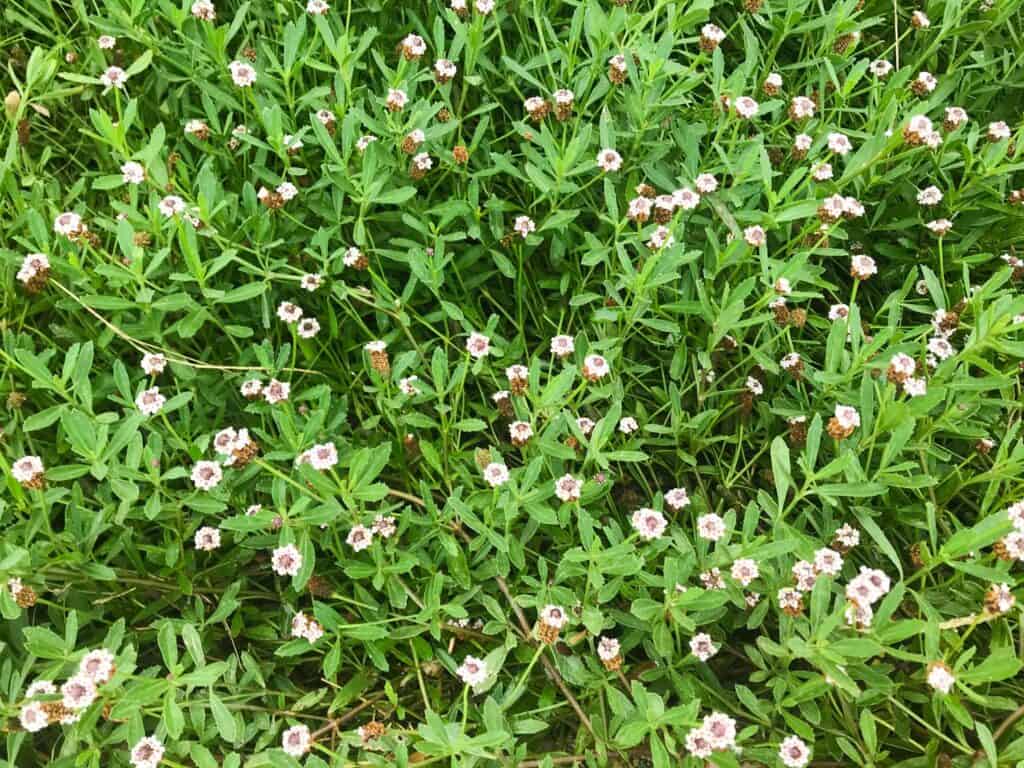
4. Scarlet Beebalm (Monarda didyma)
This beautiful plant is a favorite of hummingbirds. It prefers moist soil in full sun. Regular deadheading will help keep it blooming late into the summer.
Native to: Eastern United States
Bloom period: May – Oct.
Sun requirements: Sun to part shade
Height: 3-4 ft.
Wildlife benefits: Nectar and pollen for hummingbirds, bees, and butterflies.
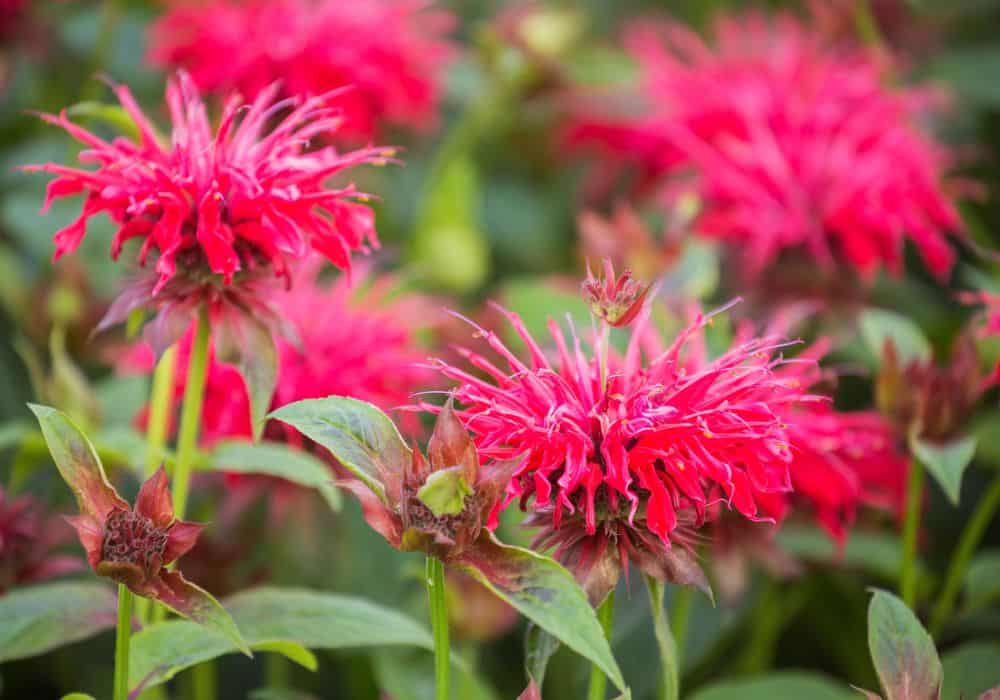
5. Wild Bergamot (Monarda fistulosa)
Another Mondara species, Wild Bergamot, has a wide native range across the U.S.. Its beautiful flowers are purplish pink and bloom throughout the summer, attracting bees and butterflies.
Native to: Most of United States
Bloom period: May-Sept.
Sun requirements: Sun to part sun
Height: 2-4 ft.
Wildlife benefits: Host to Orange Mint Moth and Hermit Sphinx Moth. Nectar and pollen for hummingbirds, bees, and butterflies.

6. Cardinal Flower (Lobelia cardinalis)
This perennial with tall stems topped with red flowers is a great choice for a big pop of red during the summer months. Plant it towards the back of your flower bed – it can grow up to 6 feet tall!
Native to: Most of the United States (except for Northwest)
Bloom period: May – Oct.
Sun requirements: Sun to part shade
Height: 3-6 ft.
Wildlife benefits: Nectar and pollen for hummingbirds, bees, and butterflies.
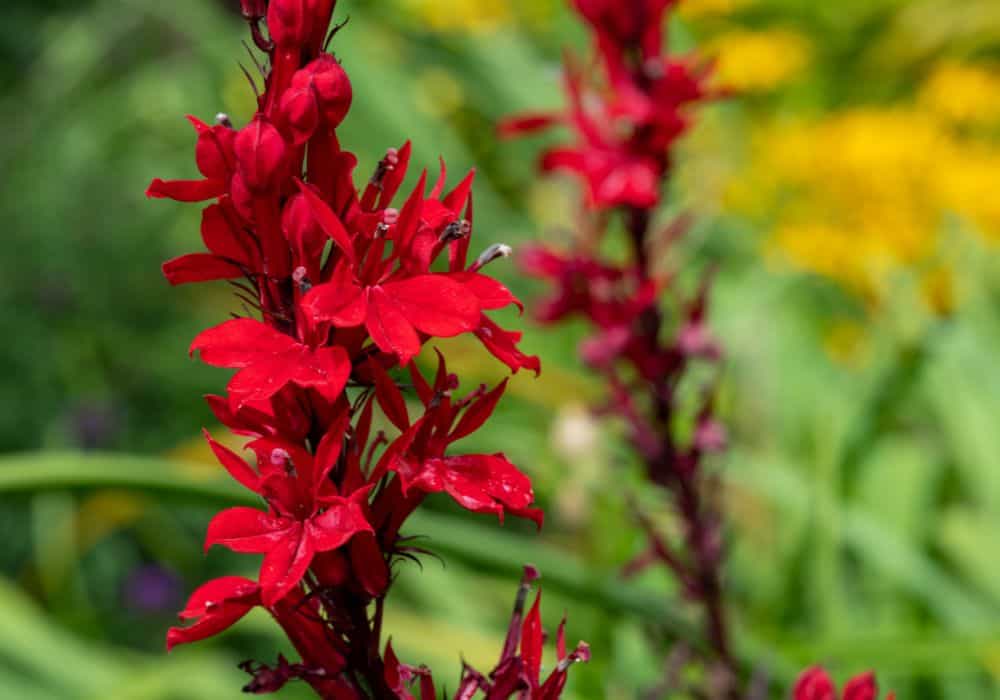
7. Spotted Joe Pye Weed (Eutrochium maculatum)
Spotted Joe Pye Weed is one of several different varieties of Joe Pye Weed native to the United States. All of them are great options for your garden. Pick the one that is native to your local area. Another good reason to grow Joe Pye Weed? It is an important moth host plant!
Native to: Northern half of United States
Bloom period: July – Oct.
Sun requirements: Full sun to part sun.
Height: 3-5 ft.
Wildlife benefits: Host plant to several moth species. Its fragrant flowers are a great source of nectar and pollen for pollinators.
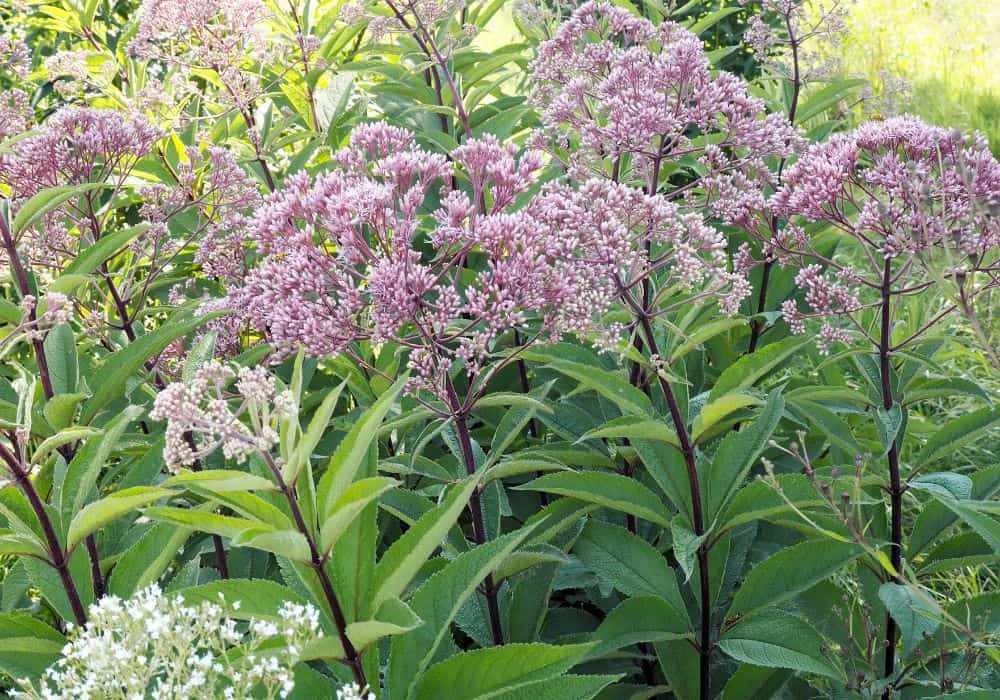
8. Hyssop (Agastache foeniculum)
If you live in the northern U.S., try Hyssop in your perennial garden. It starts blooming in mid summer and can bloom consistently for up to three months, attracting lots of bees and butterflies while in full bloom.
Native to: Northern United States
Bloom period: Mid-summer to mid-fall
Sun requirements: Sun to part shade
Height: 2-4 ft.
Wildlife benefits: Nectar and pollen source for pollinators.
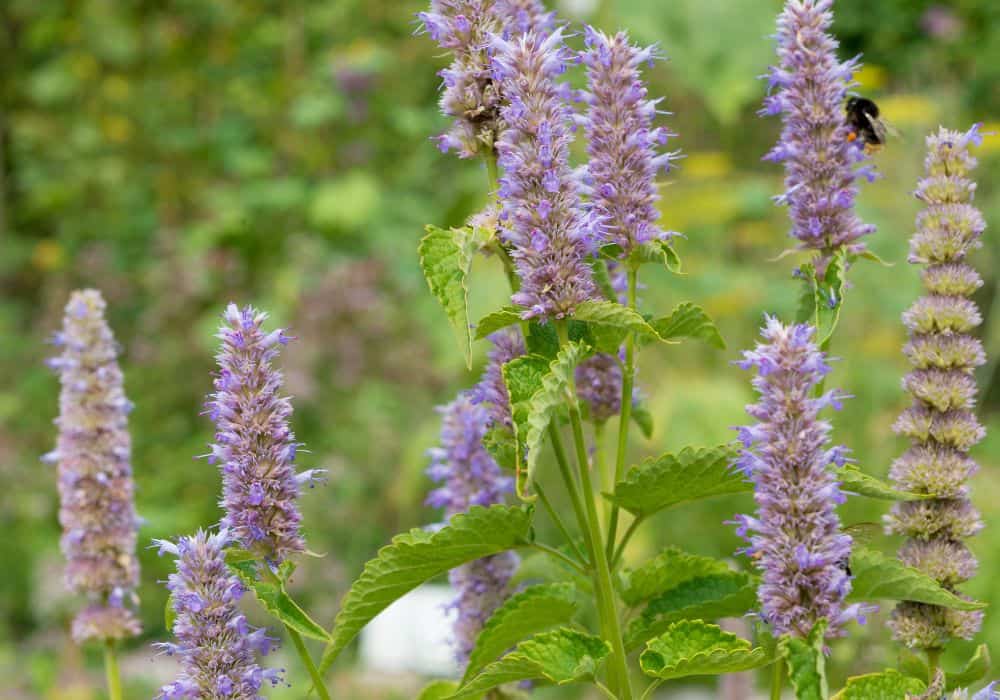
9. Yarrow (Achillea millefolium)
Yarrow is native to many parts of the world. This pretty plant is known for its ferny foliage and clusters of white blossoms. It makes an excellent cut flower.
Native to: Most of the United States (throughout Europe and Asia as well!)
Bloom period: July – Oct.
Sun requirements: Sun to part shade
Height: 1-3 ft.
Wildlife benefits: Host plant for Painted Lady butterflies. Provides nectar and pollen for pollinators.
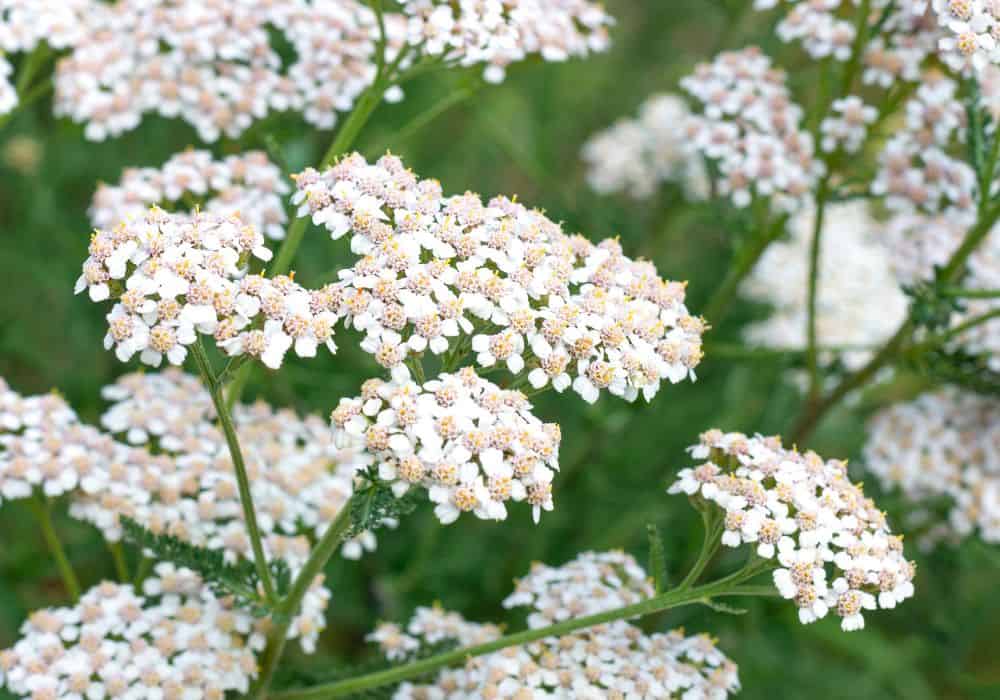
10. Tropical Sage (Salvia coccinea)
If you live in the Southeast, this bright red Salvia has a long bloom period that stretches from early spring to fall. Tropical Sage is a low-maintenance plant grows well in both sun and shade.
Native to: Southeastern United States
Bloom period: Feb – Oct.
Sun requirements: Sun to shade
Height: 1-3 ft.
Wildlife benefits: Nectar and pollen for pollinators.

Download the PDF: 10 Long-Blooming Perennials
I created a handy one-page PDF for you to print and take along with you to the plant nursery. It includes a thumbnail photo of each plant along with both its common and scientific name and helpful growing info. Get it here:
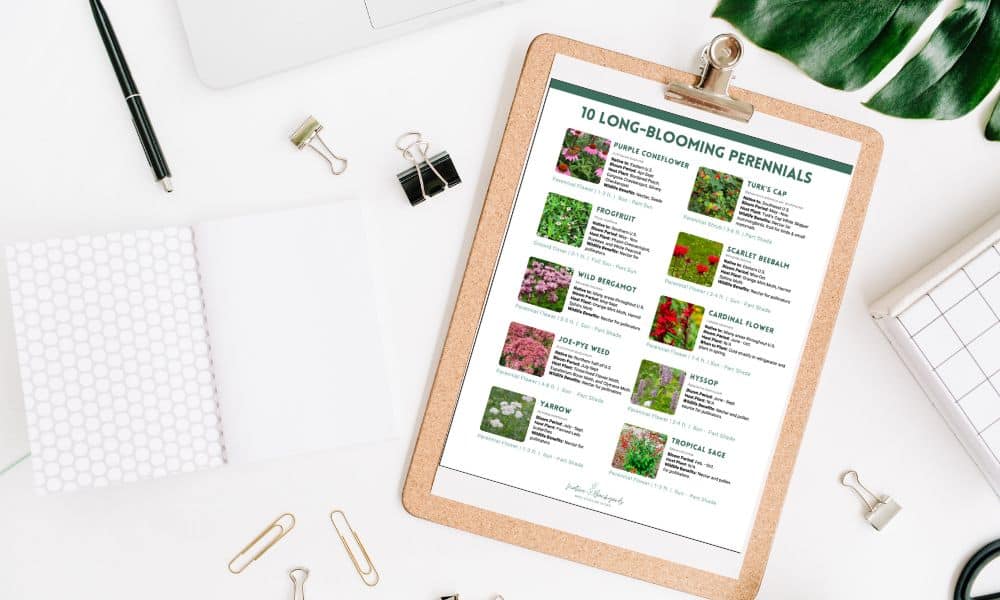
Bonus: 7 Texas perennial flowers that bloom all summer
If you live in Texas like I do, I have a special list for you! These Texas perennials have adapted to bloom in dry climates with occasional extreme heat.
They don’t mind dry soil or drought conditions. In other words, they are the perfect choice for your summer garden!
1. Zexmenia (Wedelia acapulcensis var. hispida)
A low-maintenance and drought resistant plant. Perfect for a rock garden or trailing over a rock wall. This long blooming perennial covered in yellow flowers is a winner for a sunny spot in your Texas garden!
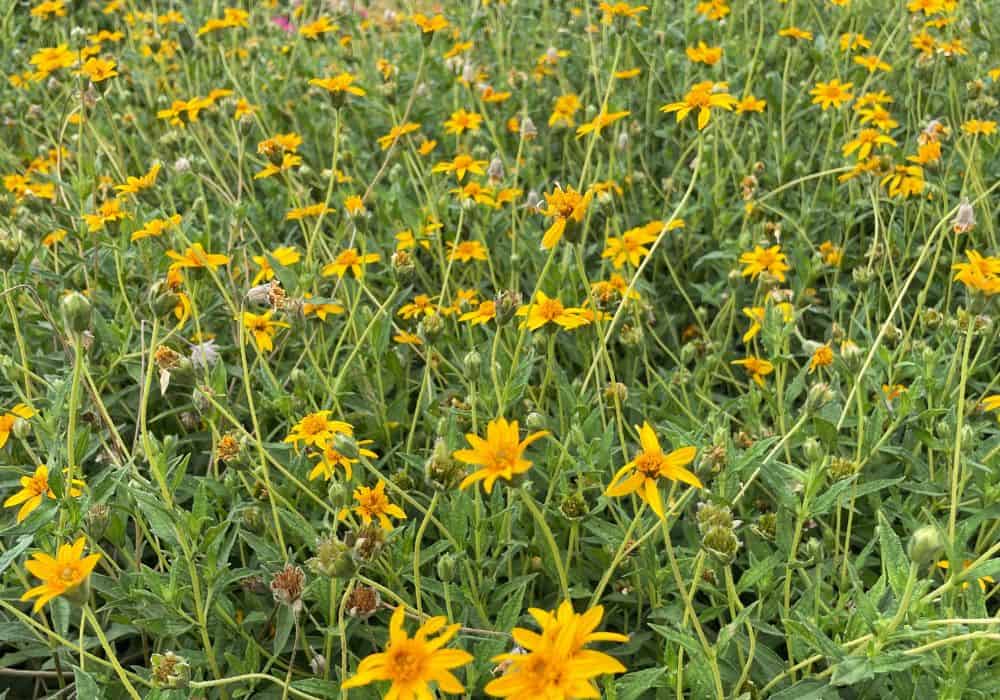
2. Esperanza (Tecoma stans)
Esperanza is a beautiful shrub with gorgeous flowers found in landscaping across South Texas. It can start blooming as early as April and continue through October.
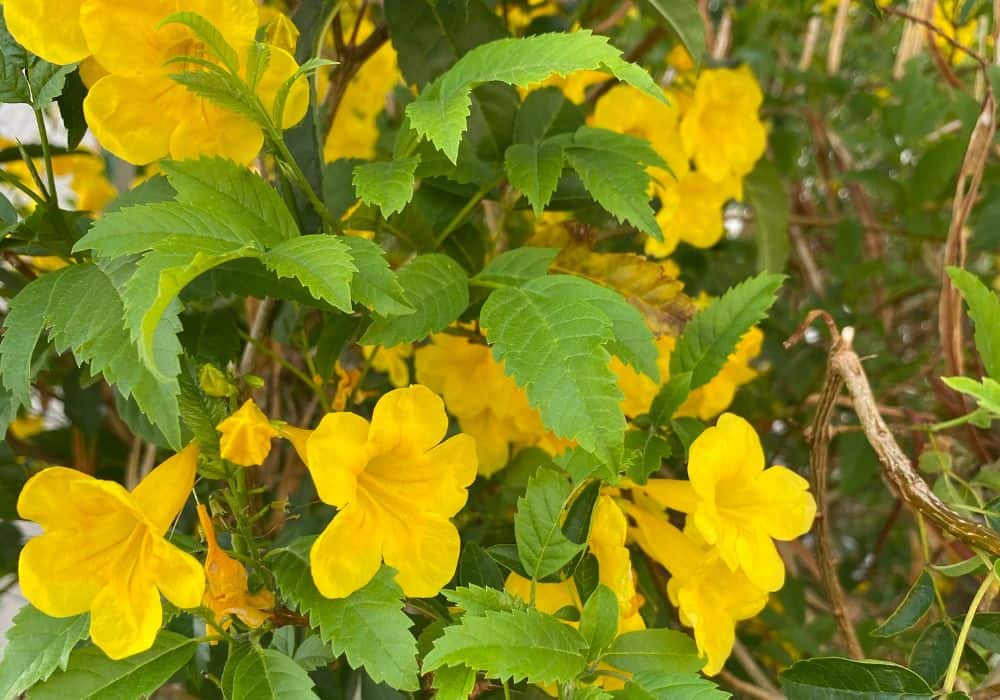
3. Gregg’s Mistflower (Conoclinium greggii)
A good reason to plant Gregg’s Mistflower is to attract Queen butterflies to your yard. They love to nectar on its showy blooms. Gregg’s Mistflower does best in full sun but can handle light shade.
Don’t have room for Gregg’s Mistflower in your garden bed? Plant it in a group of containers to welcome in the butterflies!
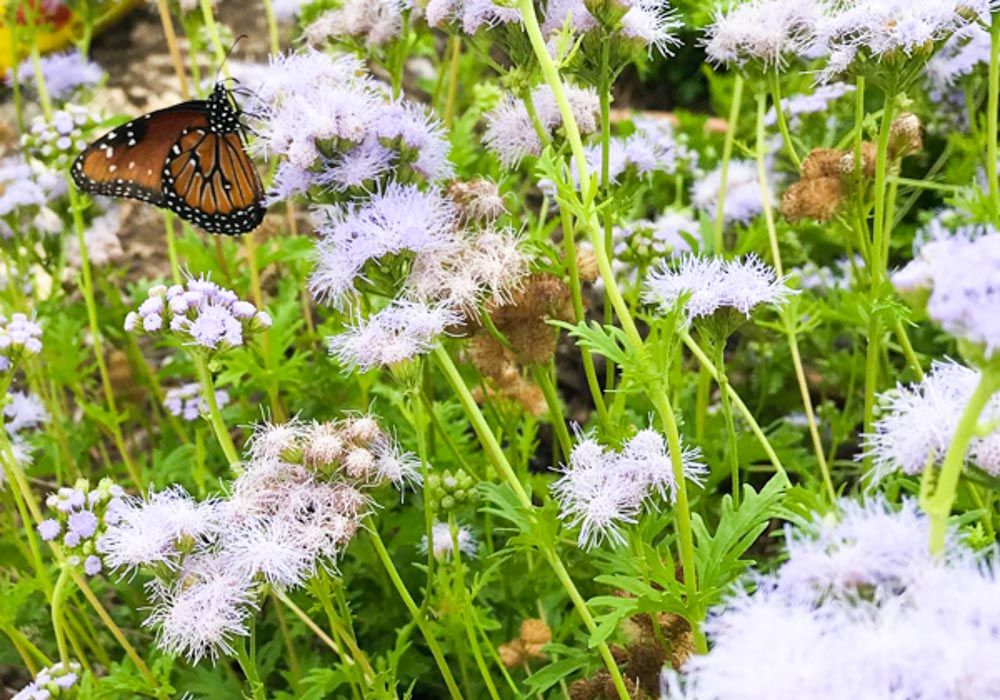
4. Flame Acanthus (Anisacanthus quadrifidus)
Flame Acanthus is one of the best drought-tolerant plants for your Texas garden. Its red flower heads attract hummingbirds and butterflies. This tough shrub can handle lots of hours of sun and very little care.
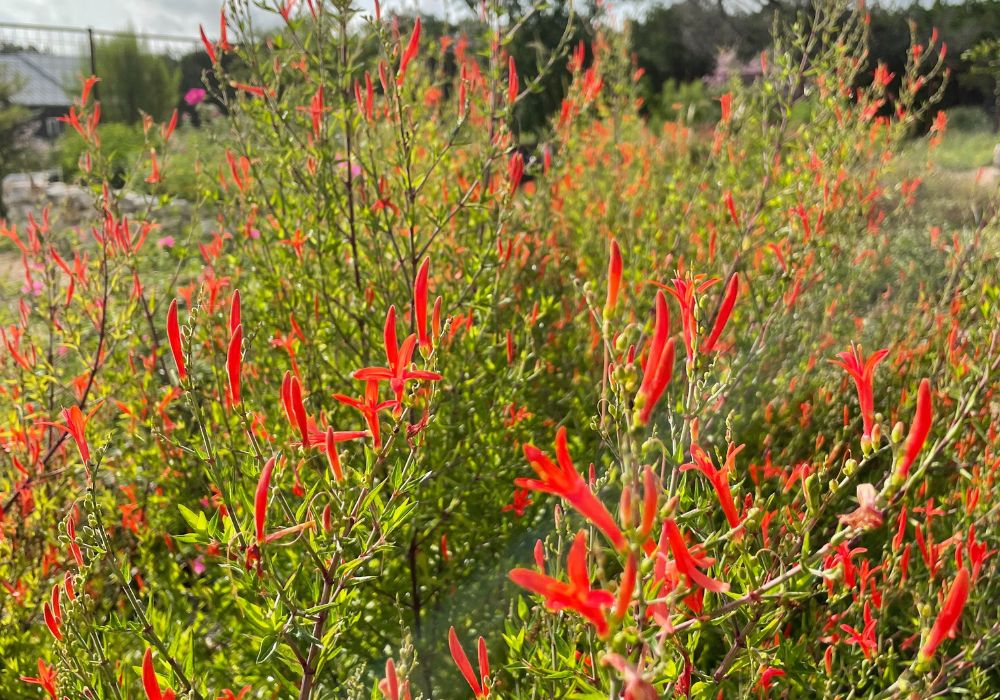
5. Autumn Sage (Salvia greggii)
Autumn Sage comes in different colors including red, pink, and white. It likes good drainage and blooms most profusely in full sun. While Salvia greggii has a long growing season, it tends to bloom in waves. You can encourage it to bloom more with regular dead-heading.
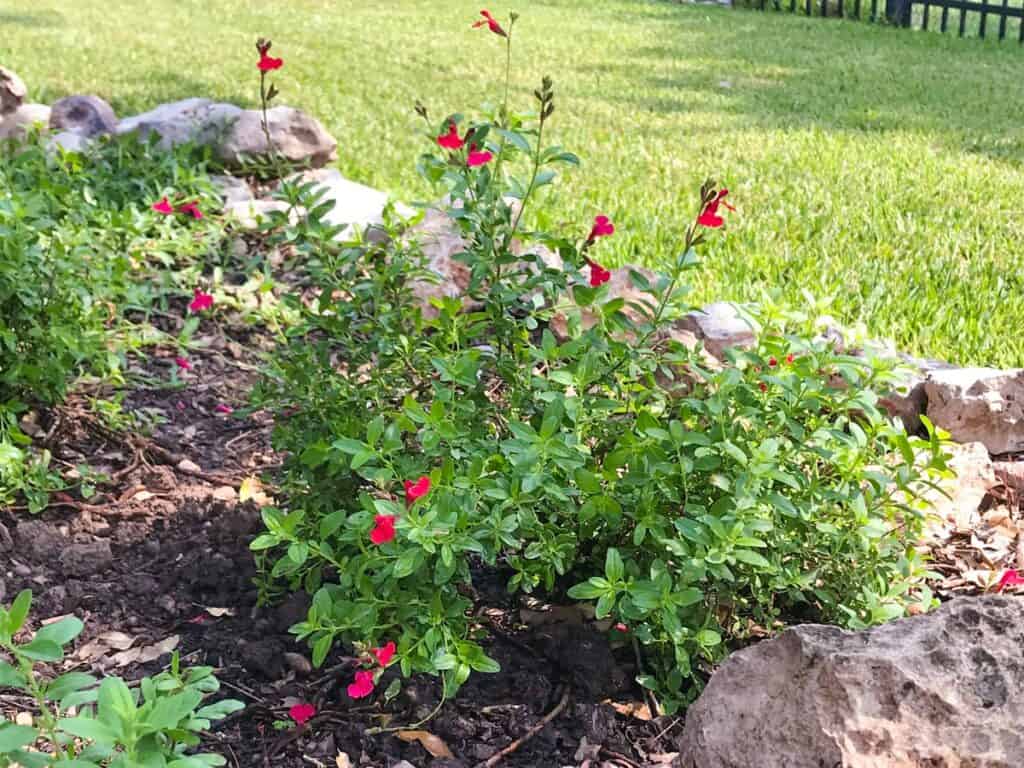
6. Mealy Blue Sage (Salvia farinacea)
I absolutely love Mealy Blue Sage – it is the ideal plant to attract bumblebees to your yard.
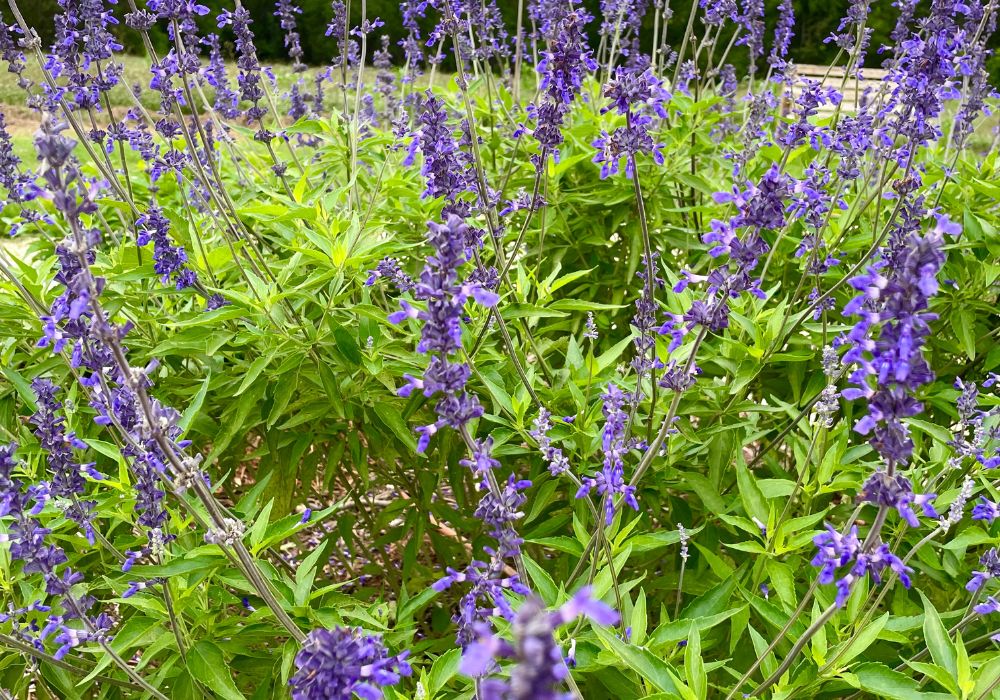
7. Texas Lantana (Lantana urticoides)
These are tough plants that look great in a rock garden. Lantana comes in a wide variety of bright colors but many are non-native (and sometimes invasive). Make sure to look for Texas Lantana by its scientific name “Lantana urticoides“.
Texas Lantana has a long bloom period but tends to flower in waves. Its red and orange flowers attract a variety of butterflies.
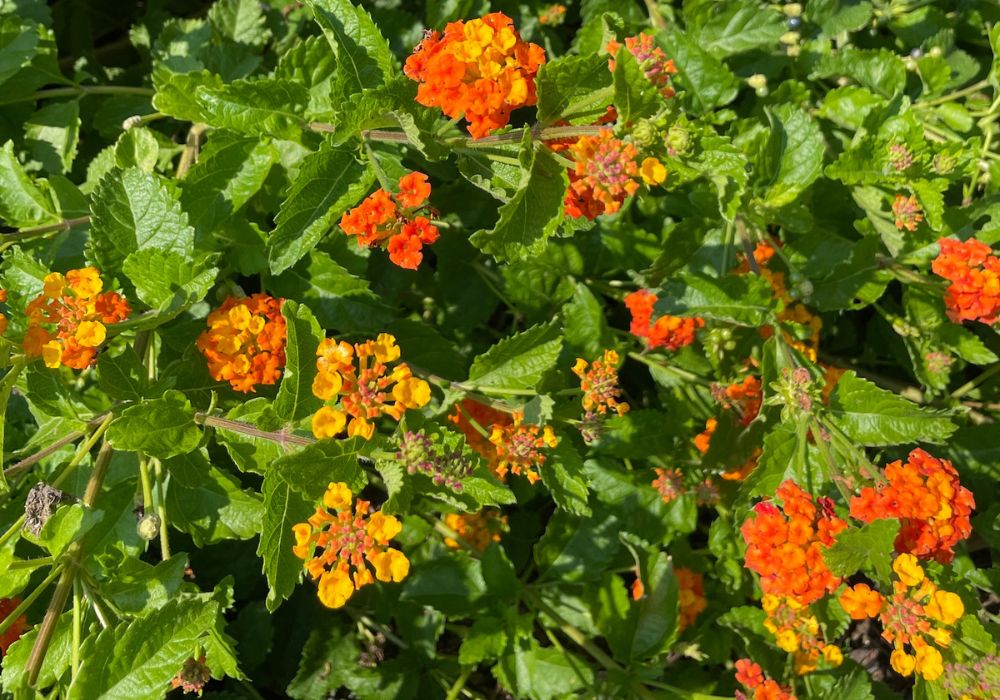
Where to find native perennials to purchase
Skip the big box garden centers and seek out a locally-owned nursery that carries native plants. Early fall is one of the best time to plant perennials and sow seeds for native wildflowers. My favorite source for native perennial and annual seeds is Native American Seed.
Pin this to help spread the word about natives!
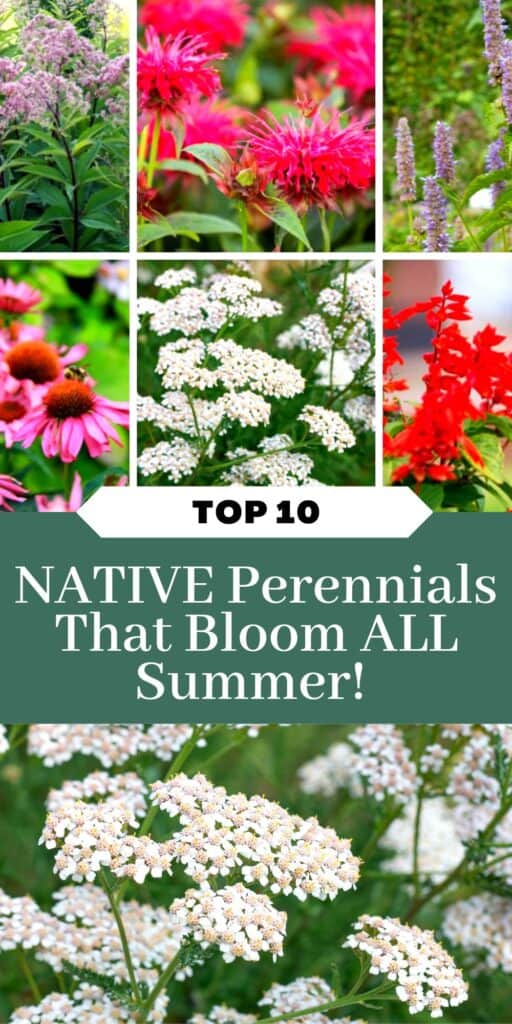
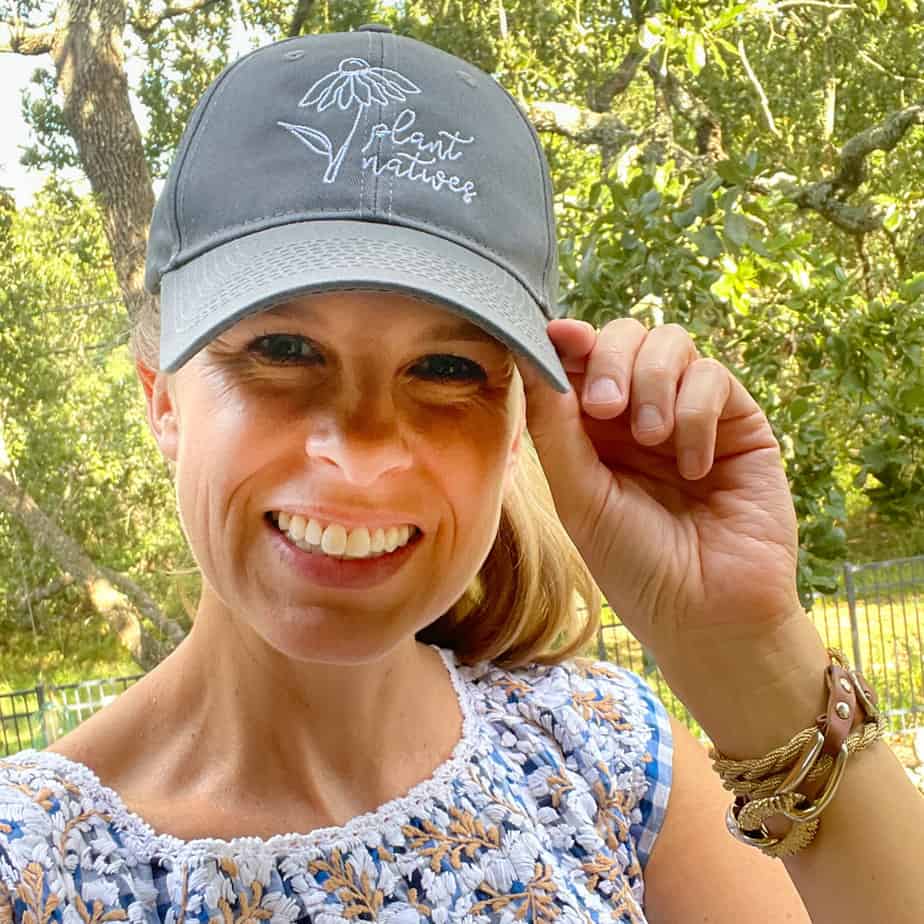
Welcome to Native Backyards! I’m Haeley from San Antonio, Texas, and I want to help you grow more native plants.
I have seen firsthand how the right plants can bring your yard to life with butterflies, bees, and birds. I’ve transformed my yard with Texas natives and I’m excited to share what I’ve learned with you.
Join my newsletter here! – each week I’ll send you helpful tips to make your native plant garden a reality!
Want to learn more about me and my garden? Check out my About page!
